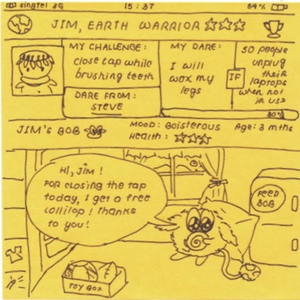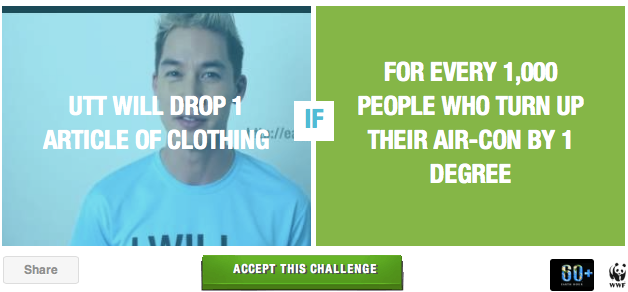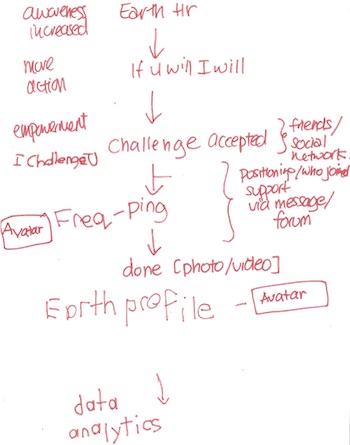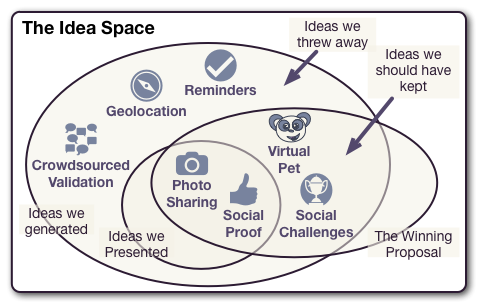You shouldn’t try to tell people how to adapt. You should just nudge them in the right direction.
— Jonas Eliasson, TEDx Helvetia, September 2012

If you’re looking to design a mobile application to further your company’s public relation efforts or otherwise motivate the public to do your bidding, this article will show you how. These are a hard-earned lessons that we obtained during the Earth Hour hackathon last January.
So the backstory is that I attended an ideation competition last January organized by Newton Circus as part of their UP Singapore project. Structured as a hackathon, the event was primarily driven by the World Wildlife Fund (WWF) as a way to crowdsource mobile application ideas for their upcoming Earth Hour event. This is the last of a two-part series and speaks about the idea that we developed during the event, how we chose to strike out some elements of our idea that turned out to be crucial for winning the event, and what were the key elements of the winning idea that you can apply to your own ideation process. Whereas the first part focuses on the team dynamics during the event.
Lessons Learned
If you’re trying to develop a mobile application to motivate people to do what you want – as long as it’s within legal and moral bounds – these are the key elements that you need to have:
- Enlist people to a higher cause. Intrinsic motivation is the best kind and people have an innate desire be part of something important and feels greater than they are – also be part of a community that opts-in to the same cause. This is probably the most important point than everything else below.
- Feature a virtual pet (tamagotchi) whose well-being is reflected in how the user’s actions matches those that you want them to do. Likely cute-looking pets with large eyes. This triggers people’s nurturing instinct and builds the reward/punishment mechanics into your application without needing to financially reward nor physically punish them. Arguably you may think that this would only be effective for female users, but remember that teenage boys also like to “dress-up” their cars (as in adding accessories, sound system upgrades, and the like), personal computers, or other objects of affection – so this approach should also work for male users, given the right type of virtual pet.
- Have pictures, lots of them. Encourage people to take photos with your application, submitting them, and show them off to their friends. People who are primarily visual thinkers forms about 60% of the population and 80% of players are socializers. Socializing photo taking is what made Instagram a big success and you can grab some of that success too.
- Incorporate social challenges. Again taking advantage of the socializers as the majority, challenges would be more fun if it’s tied to the user’s real-world friends and help foster relationships between them. Levelling up and surpassing the scores of people you know would likely be more achievable and fun rather than trying to match the world champion that’s light years ahead.
- Don’t be yet another social networking site. You’ll face an uphill battle to get people on board. It’ll be a chicken-and-egg problem since people won’t use a social network site or applications if most of their friends are not already on them. Instead identify your primary target demographic and integrate your specific experiences with the sites that they are already using. In practice, there isn’t that many social network sites tochoose from.
- Make this a free app to minimize friction in installing it. Remember that these kind of apps aren’t likely to solve specific pain points that the user has – probably solves your pain points more – and getting users to pay for it will be a tough sell. Having a paid app also inhibits the network effect that hinders the app’s mass adoption.
Our Idea
We decided to find the flaws in the Earth Hour “I Will If You Will” campaign and our proposal will be about fixing those flaws. Essentially the “I Will If You Will” campaign is a challenge posted by members of the public – and sometimes famous people – to do something silly if some number of people wants to do a particular good deed for the planet. The idea is to promote awareness for various small everyday actions that helps the ecosystem while having fun in the process.
 Our team saw that the biggest flaw in this campaign is the lack of validation in the “you will” part. All that they need to do is click on the “Accept Challenge” button to be counted as a person who did that particular challenge. There is no way to find out whether the challenge was really fulfilled. Another problem area is that the challenges tend to be one-off actions and doesn’t encourage people to be consistent in doing it all the time. That won’t be much help for the long run. For example, turning up their air-con temperature by one degree won’t save much energy if only done for one day.
Our team saw that the biggest flaw in this campaign is the lack of validation in the “you will” part. All that they need to do is click on the “Accept Challenge” button to be counted as a person who did that particular challenge. There is no way to find out whether the challenge was really fulfilled. Another problem area is that the challenges tend to be one-off actions and doesn’t encourage people to be consistent in doing it all the time. That won’t be much help for the long run. For example, turning up their air-con temperature by one degree won’t save much energy if only done for one day.

We saw that there need to be some way to validate the actions performed and keeping people engaged in incorporating environmentally-friendly actions in their daily lives. Then we designed this elaborate process of:
- Accepting challenges and announcing the challenge accepted.
- Posting proof of their good deed performed.
- Crowdsourced validation through votes (both up and down votes à’la Stack Exchange) and peer pressure.
- Building communities and tribes by facilitating camaraderie with nearby people who have accepted similar challenges.
Also we designed a reminder system to keep people engaged and continue performing fulfilling their challenges and thus doing good deeds to the environment. All of these is unified by an “earth profile” of the person that shows the “earth points” that they have accumulate. Furthermore their continuous challenge fulfillments provides nurture to a virtual pet and thus the pet’s well-being is reflected through how much good deed they’ve done for the environment and how consistent they’re doing it.

Because discussions were prolonged to very late at night we needed to quickly streamline the features and package it into a coherent workflow. Unfortunately because the team member who suggested the virtual pet idea (named “Bob”), in the process of streamlining that feature got removed along with the challenges, reminders, and various other tidbits.
We ended up of having a very streamlined “photo taking” app that augments Earth Hour’s “I Will If You Will” challenge. It focuses on the “You Will” part and allows people to submit evidences of their challenge fulfillment instead of just clicking on the “Accept Challenge” button. In turn this photo is posted to their Facebook and Twitter accounts to show their friends that they have done this good deed (and also somewhat validates the act) and to encourage their friends to do a similar good deed.
In retrospect we should have kept the virtual pet and have more iterations on making the social challenges more engaging and fun. Perhaps iterating on the virtual pet (“bob”) and make it more visually appealing thus attractive to the judges.
Anyhow you can find a copy of our presentation and clickable mockup of the app below. That’s all for now. Until next time!
0 thoughts on “How To Gamify Your Public Relations Efforts”